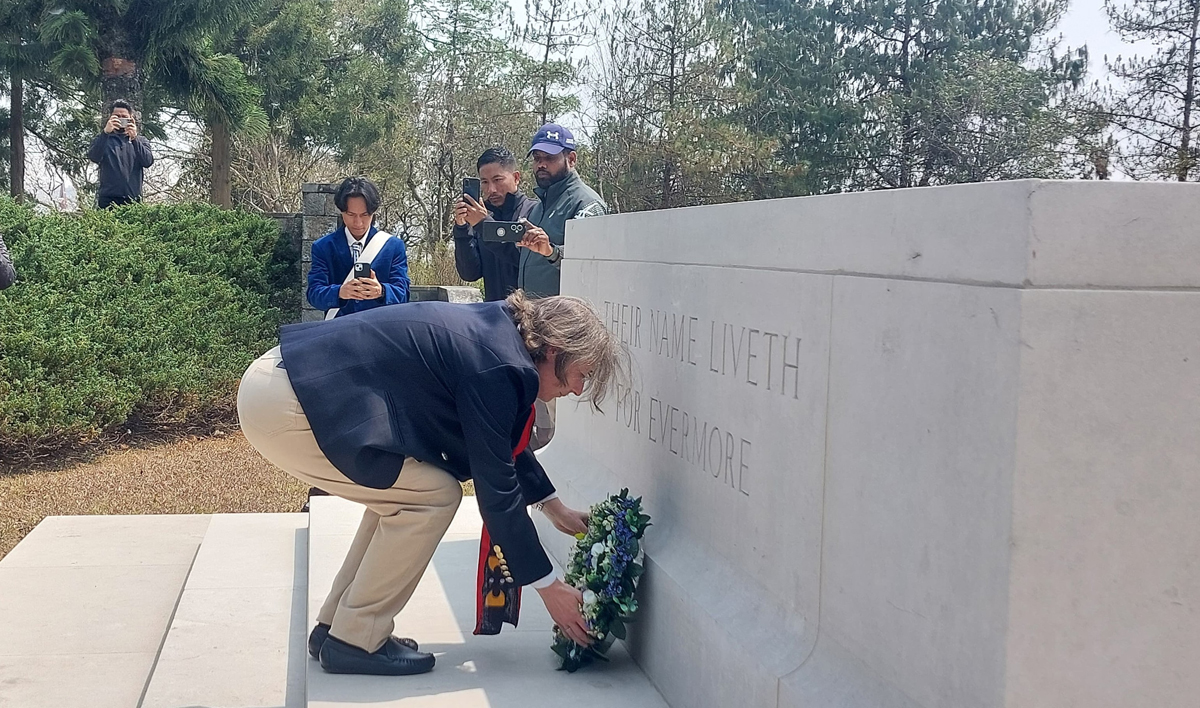FRIDAY, APRIL 25, 2025
- Home
- 81st anniversary of Battle of Kohima commemorated
81st anniversary of Battle of Kohima commemorated
Published on Apr 4, 2025
Share
 Charlotte
Carty laying a wreath at the Kohima War Cemetery on Friday.
Charlotte
Carty laying a wreath at the Kohima War Cemetery on Friday.
KOHIMA — Reflecting on the sacrifices of those who fought and gave their lives, the 81st anniversary of the Battle of Kohima was commemorated at the Kohima War Cemetery with a simple, solemn function and wreath-laying on Friday.
Charlotte Carty, a “WW-II enthusiast”—whose grandfather, Lt Col ‘Bruno’ Brown, was the Commander of the Assam Regiment during the battles of Jessami and Kohima—pointed out that the Battle of Kohima was fought initially by a very small group of soldiers through the first two and a half weeks, where they were totally surrounded.
Many of those soldiers, she said, were actually Indians, many of whom had come as part of the Assam Regiment.
Carty stated that the Assam Regiment were originally posted at Jessami and Kharasom but were asked to withdraw to Kohima to bolster the defences because, at the time, the town was not very well defended. It was realised—though very late—by Allied headquarters that it was going to be a pivotal moment, and so the Assam Regiment was asked to come back to Kohima.
In this regard, the Assam Regiment arrived in Kohima on April 3, and by April 4, the Japanese encircled the town. The siege continued until April 20, when the 2nd Division was able to push up relieving forces from Dimapur.
But the battle continued, with the Japanese well-entrenched, fighting extremely bravely until they started to withdraw on June 1, when General Sato ordered his men to start withdrawing. Following which, the Allied forces could start pushing further through Kohima, clearing Kohima and then clearing the road down to Imphal, and then beyond back into Burma.
“So Kohima itself is the first point where the Japanese were defeated in a battle on land. It took a long time,” she said.
Related: 80th Anniversary of the Battle of Kohima commemorated
According to her, the situation then was not just militarily critical, but it was absolutely grim fighting—hand-to-hand fighting, close contact night and day. “The men on the hill were completely surrounded. So for the first two and a half weeks, getting any water was very difficult. Food was limited; supplies of ammunition were dwindling. They were only resupplied—the only way they could continue was by being resupplied by air,” she described.
Carty maintained that the Japanese fought bravely and ferociously, adding that it was such intense fighting that made the Battle of Kohima stand out—remembered dearly for the cost of that battle in terms of the human aspect of it.
“But also it marks the very furthest point that the Japanese extended west on their campaign, which is one of the reasons that it's again recognised as an important battle,” she said.
She stated that the Jessami-Kohima route they undertook this year was the closest they could recreate from the historical records they have.
She also shared the possibility of recreating other routes, which other regiments undertook towards Kohima from the main road via Jotsoma and then behind Mt Puliebadze to come down onto what was known then as the General Purposes Transport (GPT) Ridge.
She recalled that at that time, the Nagas, when asked to help—which they were very happy to do—were very great and supportive of all the Allied efforts.
“Without the Nagas, the Allies wouldn't have been successful here at Kohima. And when they were asking the Nagas for a guide and support to take the troops around, the Nagas were saying, ‘Even we don't go there,’” she said.
The wreath-laying parade was done by the Ex-Servicemen League Kohima.

